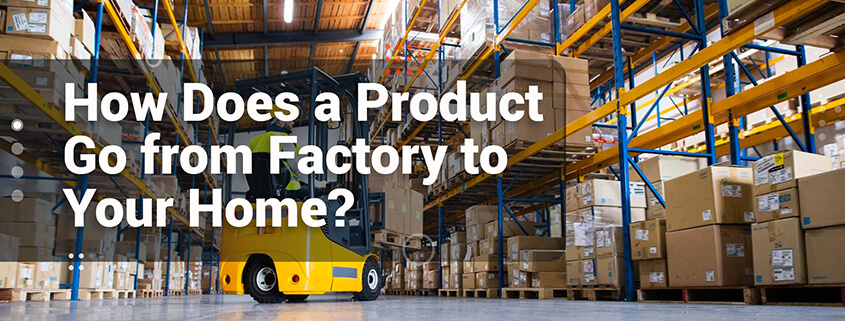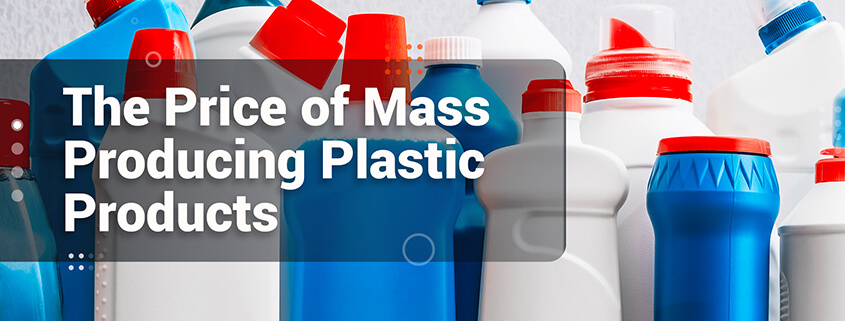If you have wondered exactly how a product travels from a large industrial factory to your kitchen counter, then today’s blog post will help clear that up. Cell phones don’t grow on trees after all. Today we are going to dive into this process with some tangible examples that make it easy to understand. In this article, we will go over the different stops your product makes along the way and the decisions you will need to make on its journey.
First, let’s start with a little roadmap. This is a very common path your product might take after it’s been designed and is ready to make the long trip from a factory overseas to the shelves at a local shop.
Suppliers → Manufacturer → Distributor → Retailer → Consumers
There are a lot of ways the supply chain can look, but today we want to focus on the supply chain in corporate businesses that involve manufacturers. We will look at what happens at each of these stops and the various paths a product takes.
Step 1—Suppliers
Before a product is even put together, you will need supplies. The supplier provides these raw materials which are then assembled and combined in a way to make the product itself. There might also be other suppliers and stages as well, but for now let’s just clump them together as one.
Once you find a factory or manufacturer to work with, you probably won’t be involved in choosing a supplier, but it helps to see the whole picture. For example, if you are selling an umbrella, then it is made up of fabric to keep the rain off and plastic or metal to provide the structure.
Step 2—Manufacturer
After you have made a prototype, you need to look at samples. Factories can send samples much quicker than they can regular products because a sample isn’t meant to be sold, so there is no need for taxes or tariffs. Import and export laws are designed for large quantities of goods, so that’s why samples can get around this loophole.
You might go through 2 or 3 revisions of the product before you are ready to place your full order. In fact, the samples are likely to be destroyed as they undergo things like testing. These tests might be performed by your own team or a third party to meet certain certification requirements.
If we continue with the example of the umbrella, maybe the fabric wasn’t as waterproof as needed and so in testing it was destroyed as a result. Knowing that flaw, you would make the necessary changes and ask for another sample.
Here is a quick breakdown of how that might look:
Sample→ Tests & Certifications → Revisions→ More Samples → Approval → Place Order
Luckily, because you are only ordering a handful of the product, you can get them quickly to speed up the process. After tweaking it, you’ll eventually get to place your order with the factory, which should take about a month.
Shipping & Logistics
When it comes to logistics, we’ll only be able to scratch the surface. Some people spend years studying this. Once your product is created and packaged, you have to make a decision on how to transport it. Even deciding on the packaging is a complicated process, but we will cover that in another article.
Let’s look at the different ways to ship your product overseas. There are 2 common methods used to transport your goods, by Air Freight or Ocean Freight. Many companies might use both for different products, but what you need to know is each one has its own pros and cons. Both have to follow their own set of rules and regulations that they have to abide by.
Here is a table to compare the two:
| Variables | Air Freight | Ocean Freight |
| Time | Faster | Slower |
| Cost | More Expensive | Less Expensive |
| Reliability | More unpredictable | More predictable |
| Destinations | More Options Inland | Must Arrive by Port |
| How they Charge | By Weight | By Volume |
If you were shipping something small and light, then sending it by air might make sense. By comparison, if you are shipping a larger quantity of something bigger and heavier, then it’s preferable to send it by ocean. Obviously, there are a number of factors that will affect your decision at the end of the day.
As we recently experienced the Suez Canal Crisis, you might end up having to switch methods due to unforeseen circumstances. When shipping things internationally, not everything is in your control, so it is important to ensure you keep this in mind, especially when drafting your budget.
Customs
After it travels by sea or by air, your product will also have to go through customs when it’s crossing international borders. There are 4 basic steps that occur when the products are being imported into a country like Canada:
- Entry. The first thing you need to do is determine how your product comes into the country and where.
- Examination and valuation. Once it arrives at the border, it’s then looked at to ensure it’s legal and the value is also evaluated so that duties or tariffs can be applied.
- Classification. After the cost is calculated, the product is classified and you can then find out the percentage of tax that is going to be charged.
- Payment and liquidation. At this stage, you will have to pay any tariffs or duties to bring it into the country.
There are a lot of forms and paperwork at this point, so you can experience delays if things aren’t filled out correctly. As you might expect, there are people who spend years studying this and keeping up with the laws and regulations.
Some companies even find loopholes to avoid paying certain taxes and there are plenty of humorous incidents that have been reported as a result. One Ukrainian importer found it was easier to cut their cars in half and import them as “car parts” instead of cars because the taxes were lower. They then reassembled the cars after they arrived at their destination.
Step 3—Distributors
Now that the product has passed through customers, it will go to a distributor. At this point, it will likely go to a warehouse or a wholesaler. Let’s look at how that looks for both of those scenarios.
After everything arrives at a warehouse, you can start sending the product in 2 different ways. These are both considered examples of the order fulfillment process, which consists of receiving and processing the goods so they can be distributed to customers.
- In-House Fulfillment. Fulfilling the orders yourself.
- Outsourced Fulfillment. Hiring another company to fulfill orders.
When you ship the products yourself, it’s also referred to as Fulfillment by Merchant (FBM). Conversely, you could work with a large company like Amazon to distribute your products. Fulfillment by Amazon (FBA) is a popular option of outsourced fulfillment by many, but you should know that they will take a percentage of the sales. These types of fulfillment centres will also charge a storage fee as they have to make space to store your product until it is sold.
Another way to distribute your product is through a wholesaler. People sometimes use the term interchangeably with distributor; however, a wholesaler is a company that acts as an intermediary between the manufacturers and retailers. Wholesalers will buy the products from a manufacturer in bulk, then sell them to the retailers.
There are many different types of distributors and wholesalers out there helping you get your product in the hands of your consumers. Similar to shipping, you need to weigh the costs and choose what is best for you.
Step 4—Retailer & Consumers
Finally, after a few months of sitting in shipping containers traversing the ocean and bumbling around on trucks from warehouses to stores, the product winds up in the hands of your customers. It’s a complicated and convoluted journey, but we hope that we have demystified it for you.
While it might seem daunting, we wanted to show the whole process and the different paths a product can take on its journey after it’s designed and ready to go. You might think you can jump straight from placing the order to marketing, but there are a lot of steps after you’ve ordered your product from the factory.
If you found this article helpful, don’t forget to share it and subscribe to our newsletter for more useful content like this.
About the Author
Ventrify is a product design and manufacturing firm that helps entrepreneurs bring product ideas from concept to market. We take in fledgling ideas and bring them through our iterative design process to create products our clients are proud of. Then, we work with manufacturing facilities worldwide to bring our clients the highest quality products at competitive prices.
If you have questions or want to discuss going remote, reach out to us through our Website, Facebook, or LinkedIn.
Article by Victoria Fraser



